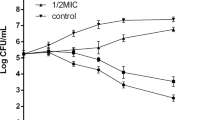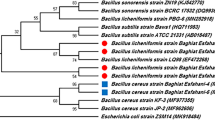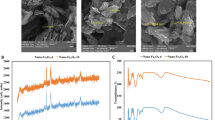Abstract
Candida albicans can readily form biofilms on both inanimate and biological surfaces. In this study we investigated a means of inhibiting biofilm formation using EDTA (Ethylenediaminetetra-acetic acid), a divalent cation chelating agent, which has been shown to affect C. albicans filamentation. Candida albicans biofilms were formed in 96-well microtitre plates. Cells were allowed to adhere for 1, 2, and 4 h at 37°C, washed in PBS, and then treated with different concentrations of EDTA (0, 2.5, 25, and 250 mM). EDTA was also added to the standardized suspension prior to adding to the microtiter plate and to a preformed 24 h biofilm. All plates were then incubated at 37°C for an additional 24 h to allow for biofilm formation. The extent and characteristics of biofilm formation were then microscopically assessed and with a semi-quantitative colorimetric technique based on the use of an XTT-reduction assay. Northern blot analysis of the hyphal wall protein (HWP1) expression was also monitored in planktonic and biofilm cells treated with EDTA. Microscopic analysis and colorimetric readings revealed that filamentation and biofilm formation were inhibited by EDTA in a concentration dependant manner. However, preformed biofilms were minimally affected by EDTA (maximum of 31% reduction at 250 mM). The HWP1 gene expression was reduced in EDTA-treated planktonic and biofilm samples. These results indicate that EDTA inhibits C. albicans biofilm formation are most likely through its inhibitory effect on filamentation and indicates the potential therapeutic effects of EDTA. This compound may serve a non-toxic means of preventing biofilm formation on infections with a C. albicans biofilm etiology.
Similar content being viewed by others
References
Beck-Sague C, Jarvis WR. Secular trends in the epidemiology of nosocomial fungal infections in the United States, 1980–1990. National Nosocomial Infections Surveillance System. J Infect Dis 1993;167:1247–51.
Viudes A, Peman J, Canton E, Ubeda P, Lopez-Ribot JL, Gobernado M. Candidemia at a tertiary-care hospital: epidemiology, treatment, clinical outcome and risk factors for death. Eur J Clin Microbiol Infect Dis 2002;21:767–74.
Kojic EM, Darouiche RO. Candida infections of medical devices. Clin Microbiol Rev 2004;17:255–67.
Nikawa H, Nishimura H, Hamada T, Kumagai H, Samaranayake LP. Effects of dietary sugars and, saliva and serum on Candida bioflim formation on acrylic surfaces. Mycopathologia 1997;139:87–91.
Ramage G, Martinez JP, Lopez-Ribot JL. Candida biofilms on implanted biomaterials: a clinically significant problem. FEMS Yeast Res 2006;6:979–86.
Jin Y, Zhang T, Samaranayake YH, Fang HH, Yip HK, Samaranayake LP. The use of new probes and stains for improved assessment of cell viability and extracellular polymeric substances in Candida albicans biofilms. Mycopathologia 2005;159:353–60.
Ramage G, Saville SP, Thomas DP, Lopez-Ribot JL. Candida biofilms: an update. Eukaryot Cell 2005;4:633–8.
Costerton JW, Stewart PS, Greenberg EP. Bacterial biofilms: a common cause of persistent infections. Science 1999;284:1318–22.
Donlan RM. Biofilm formation: a clinically relevant microbiological process. Clin Infect Dis 2001;33:1387–92.
Berman J, Sudbery PE. Candida Albicans: a molecular revolution built on lessons from budding yeast. Nat Rev Genet 2002;3:918–30.
He M, Du M, Fan M, Bian Z. In vitro activity of eugenol against Candida albicans biofilms. Mycopathologia 2007;163(3):137–43.
Lopez-Ribot JL. Candida albicans biofilms: more than filamentation. Curr Biol 2005;15:R453–5.
Nett J, Andes D. Candida albicans biofilm development, modeling a host-pathogen interaction. Curr Opin Microbiol 2006;9:340–5.
Nobile CJ, Mitchell AP. Genetics and genomics of Candida albicans biofilm formation. Cell Microbiol 2006;8:1382–91.
Baillie GS, Douglas LJ. Role of dimorphism in the development of Candida albicans biofilms. J Med Microbiol 1999;48:671–9.
Nobile CJ, Andes DR, Nett JE, Smith FJ, Yue F, Phan QT, et al. Critical role of Bcr1-dependent adhesins in C. albicans biofilm formation in vitro and in vivo. PLoS Pathog 2006;2:e63.
Ramage G, VandeWalle K, Lopez-Ribot JL, Wickes BL. The filamentation pathway controlled by the Efg1 regulator protein is required for normal biofilm formation and development in Candida albicans. FEMS Microbiol Lett 2002;214:95–100.
Nobile CJ, Mitchell AP. C. albicans transcription factor Bcr1p: a regulator of cell-surface genes and biofilm formation. Curr Biol 2005;15:1150–5.
Nobile CJ, Nett JE, Andes DR, Mitchell AP. Function of Candida albicans adhesin Hwp1 in biofilm formation. Eukaryot Cell 2006;5:1604–10.
Ramage G, Saville SP, Wickes BL, Lopez-Ribot JL. Inhibition of Candida albicans biofilm formation by farnesol, a quorum-sensing molecule. Appl Environ Microbiol 2002;68:5459–63.
Gil ML, Casanova M, Martinez JP. Changes in the cell wall glycoprotein composition of Candida albicans associated to the inhibition of germ tube formation by EDTA. Arch Microbiol 1994;161:489–94.
Percival SL, Kite P, Eastwood K, Murga R, Carr J, Arduino MJ, et al. Tetrasodium EDTA as a novel central venous catheter lock solution against biofilm. Infect Control Hosp Epidemiol 2005;26:515–9.
Raad I, Chatzinikolaou I, Chaiban G, Hanna H, Hachem R, Dvorak T, et al. In vitro and ex vivo activities of minocycline and EDTA against microorganisms embedded in biofilm on catheter surfaces. Antimicrob Agents Chemother 2003;47:3580–5.
Ramage G, Vande Walle K, Wickes BL, Lopez-Ribot JL. Standardized method for in vitro antifungal susceptibility testing of Candida albicans biofilms. Antimicrob Agents Chemother 2001;45:2475–9.
Ramage G, VandeWalle K, Wickes BL, Lopez-Ribot JL. Characteristics of Biofilm Formation by Candida albicans. Rev Iberoam Micol 2001;18:163–70.
Ramage G, Bachmann S, Patterson TF, Wickes BL, Lopez-Ribot JL. Investigation of multidrug efflux pumps in relation to fluconazole resistance in Candida albicans biofilms. J Antimicrob Chemother 2002;49:973–80.
Staab JF, Sundstrom P. Genetic organization and sequence analysis of the hypha-specific cell wall protein gene HWP1 of Candida albicans. Yeast 1998;14:681–6.
Saville SP, Lazzell AL, Monteagudo C, Lopez-Ribot JL. Engineered control of cell morphology in vivo reveals distinct roles for yeast and filamentous forms of Candida albicans during infection. Eukaryot Cell 2003;2:1053–60.
Turakhia MH, Cooksey KE, Characklis WG. Influence of a calcium-specific chelant on biofilm removal. Appl Environ Microbiol 1983;46:1236–8.
Harrison JJ, Turner RJ, Ceri H. A subpopulation of Candida albicans and Candida tropicalis biofilm cells are highly tolerant to chelating agents. FEMS Microbiol Lett 2007;272:172–81.
Acknowledgments
Gordon Ramage is the recipient of an International Association for Dental Research (IADR)/GlaxoSmithKline (GSK) award for Oral Innovation. José L. López-Ribot was the recipient of a New Investigator Award in Molecular Pathogenic Mycology from the Burroughs Wellcome Fund. This work was supported by grant ATP 3659-0080 from the Texas Higher Education Coordinating Board (Advance Technology Program, Biomedicine).
Author information
Authors and Affiliations
Corresponding author
Rights and permissions
About this article
Cite this article
Ramage, G., Wickes, B.L. & López-Ribot, J.L. Inhibition on Candida albicans biofilm formation using divalent cation chelators (EDTA). Mycopathologia 164, 301–306 (2007). https://doi.org/10.1007/s11046-007-9068-x
Received:
Accepted:
Published:
Issue Date:
DOI: https://doi.org/10.1007/s11046-007-9068-x




